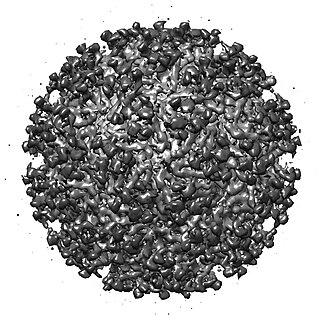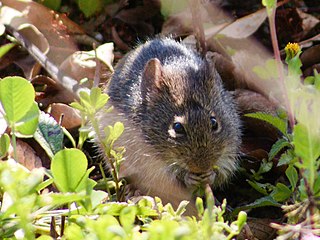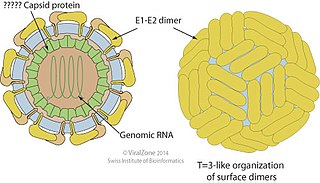
Orthohantavirus is a genus of single-stranded, enveloped, negative-sense RNA viruses in the family Hantaviridae of the order Bunyavirales. Members of this genus may be called orthohantaviruses or simply hantaviruses. They normally cause infection in rodents, but do not cause disease in them. Humans may become infected with hantaviruses through contact with rodent urine, saliva, or feces. Some strains cause potentially fatal diseases in humans, such as hantavirus hemorrhagic fever with renal syndrome (HFRS), or hantavirus pulmonary syndrome (HPS), also known as hantavirus cardiopulmonary syndrome (HCPS), while others have not been associated with known human disease. HPS (HCPS) is a "rare respiratory illness associated with the inhalation of aerosolized rodent excreta contaminated by hantavirus particles."

Bunyavirales is an order of segmented negative-strand RNA viruses with mainly tripartite genomes. Member viruses infect arthropods, plants, protozoans, and vertebrates. It is the only order in the class Ellioviricetes. The name Bunyavirales derives from Bunyamwera, where the original type species Bunyamwera orthobunyavirus was first discovered. Ellioviricetes is named in honor of late virologist Richard M. Elliott for his early work on bunyaviruses.

An arenavirus is a bisegmented ambisense RNA virus that is a member of the family Arenaviridae. These viruses infect rodents and occasionally humans. A class of novel, highly divergent arenaviruses, properly known as reptarenaviruses, have also been discovered which infect snakes to produce inclusion body disease. At least eight arenaviruses are known to cause human disease. The diseases derived from arenaviruses range in severity. Aseptic meningitis, a severe human disease that causes inflammation covering the brain and spinal cord, can arise from the lymphocytic choriomeningitis virus. Hemorrhagic fever syndromes, including Lassa fever, are derived from infections such as Guanarito virus, Junin virus, Lassa virus, Lujo virus, Machupo virus, Sabia virus, or Whitewater Arroyo virus. Because of the epidemiological association with rodents, some arenaviruses and bunyaviruses are designated as roboviruses.

Hepacivirus is a genus of positive-strand RNA viruses in the family Flaviviridae. The hepatitis C virus (HCV), in species Hepacivirus C, infects humans and is associated with hepatitis and hepatocellular carcinoma. There are fourteen species in the genus which infect a range of other vertebrate.

Oryzomys is a genus of semiaquatic rodents in the tribe Oryzomyini living in southern North America and far northern South America. It includes eight species, two of which—the marsh rice rat (O. palustris) of the United States and O. couesi of Mexico and Central America—are widespread; the six others have more restricted distributions. The species have had eventful taxonomic histories, and most species were at one time included in the marsh rice rat; additional species may be recognized in the future. The name Oryzomys was established in 1857 by Spencer Fullerton Baird for the marsh rice rat and was soon applied to over a hundred species of American rodents. Subsequently, the genus gradually became more narrowly defined until its current contents were established in 2006, when ten new genera were established for species previously placed in Oryzomys.
Seoul orthohantavirus (SEOV) is a member of the Orthohantavirus family of rodent-borne viruses and is one of the 4 hantaviruses that are known to be able to cause Hantavirus hemorrhagic fever with renal syndrome (HFRS). It is an Old World hantavirus; a negative sense, single-stranded, tri-segmented RNA virus.

The Asiatic long-tailed climbing mouse is a species of rodent found in South and Southeast Asia. It is known as ගස් මීයා by Sinhalese people.
Puumala orthohantavirus (PUUV) is a species of Orthohantavirus. Humans infected with the virus may develop a haemorrhagic fever with renal syndrome (HFRS) known as nephropathia epidemica. Puumala orthohantavirus HFRS is lethal in less than 0.5% of the cases. Rarely, PUUV infection can cause Guillain-Barré syndrome.

Everglades virus (EVEV) is an alphavirus included in the Venezuelan equine encephalitis virus complex. The virus circulates among rodents and vector mosquitoes and sometimes infects humans, causing a febrile illness with occasional neurological manifestations. The virus is named after the Everglades, a region of subtropical wetlands in southern Florida. The virus is endemic to the U.S. state of Florida, where its geographic range mirrors that of the mosquito species Culex cedecei. Hispid cotton rat and cotton mouse are considered important reservoir hosts of Everglades virus. Most clinical cases of infection occur in and around the city of Miami.
Parechovirus is a genus of viruses in the family Picornaviridae. Humans, ferrets, and various rodents serve as natural hosts. The genus currently consists of six accepted species. Human parechoviruses may cause gastrointestinal or respiratory illness in infants, and have been implicated in cases of myocarditis and encephalitis.

The Jaliscan cotton rat or Mexican cotton rat is a species of rodent in the family Cricetidae. It is found only in Mexico. They commonly have brown fur with white fur on the belly. They are ground-dwelling and prefer open habitats.

The southern cotton rat is a rodent species in the family Cricetidae. It is found from southern Chiapas in Mexico through Central America, except for Belize, and as far east as northern Colombia and Venezuela. It lives in tropical rainforest, dry forest and savanna, as well as in cultivated areas. The species is terrestrial and primarily diurnal. It was long thought to be a subspecies of S. hispidus. However, recent taxonomic revisions, based on mitochondrial DNA sequence data, have split the extensive former species range into three separate species. Carroll et al. (2004) indicate that the southern edge of the S. hispidus distribution is likely near the Rio Grande where it meets the northern distribution of S. toltecus. The range of S. toltecus extends from northern Mexico south into Chiapas where it occurs in sympatry with S. hirsutus . Rats from this species group have been used as laboratory animals.
Brazilian hemorrhagic fever (BzHF) is an infectious disease caused by Brazilian mammarenavirus, an arenavirus. Brazilian mammarenavirus is one of the arenaviruses from South America to cause hemorrhagic fever. It shares a common progenitor with Argentinian mammarenavirus, Machupo mammarenavirus, Tacaribe mammarenavirus, and Guanarito mammarenavirus. It is an enveloped RNA virus and is highly infectious and lethal. Very little is known about this disease, but it is thought to be transmitted by the excreta of rodents. This virus has also been implicated as a means for bioterrorism, as it can be spread through aerosols.
Playa de Oro virus (OROV) is a probable species of orthohantavirus found in the rodents Oryzomys couesi and Sigmodon mascotensis in the Mexican state of Colima. The former is thought to be the main host. The sequences of parts of the virus's RNA-based genome have been determined; they differ by 7–10% in amino acid composition and 22–24% in nucleotide composition from closely related viruses.

Pegivirus is the approved name for a genus of single positive-stranded RNA viruses in the family Flaviviridae. The name is a derived one: "Pe" stands for "persistent" and "g" is a reference to Hepatitis G, a former name of the C species.

Betacoronavirus is one of four genera of coronaviruses. Member viruses are enveloped, positive-strand RNA viruses that infect mammals. The natural reservoir for betacoronaviruses are bats and rodents. Rodents are the reservoir for the subgenus Embecovirus, while bats are the reservoir for the other subgenera.

Hantavirus pulmonary syndrome (HPS) is one of two potentially fatal syndromes of zoonotic origin caused by species of hantavirus. These include Black Creek Canal virus (BCCV), New York orthohantavirus (NYV), Monongahela virus (MGLV), Sin Nombre orthohantavirus (SNV), and certain other members of hantavirus genera that are native to the United States and Canada.
El Moro Canyon orthohantavirus is a single-stranded, negative sense RNA virus of the genus Orthohantavirus. It is a causative agent of Hantavirus pulmonary syndrome.
Acara orthobunyavirus (ACAV) is a species in the genus Orthobunyavirus, belonging to the Capim serogroup. It is isolated from sentinel mice, Culex species, and the rodent Nectomys squamipes in Pará, Brazil and in Panama. The symptoms of the Acará virus is death. Sometimes reported to cause disease in humans.

Protoparvovirus is the name of a genus of viruses in the Parvovirinae subfamily of the virus family Parvoviridae. Vertebrates serve as natural hosts. There are currently 13 species in the genus including the type species Rodent protoparvovirus 1 for which the exemplar virus is minute virus of mice (MVM). This genus also includes canine parvovirus (CPV), which causes gastrointestinal tract damage in puppies that is about 80% fatal, and porcine parvovirus (PPV), which is a major cause of fetal death and infertility in pigs. The genus divides phylogenetically into two branches, one that contains many founder members of the family, such as MVM, CPV and PPV, which have been studied in considerable detail, and a second branch occupied exclusively by predicted viruses whose coding sequences were identified recently in the wild using virus discovery approaches, but whose biology remains minimally explored. This second branch currently contains two species whose members infect humans, called Primate protoparvovirus 1 and Primate protoparvovirus 3. Until 2014, the genus was called Parvovirus, but it was renamed to eliminate confusion between members of this genus and members of the entire family Parvoviridae.












